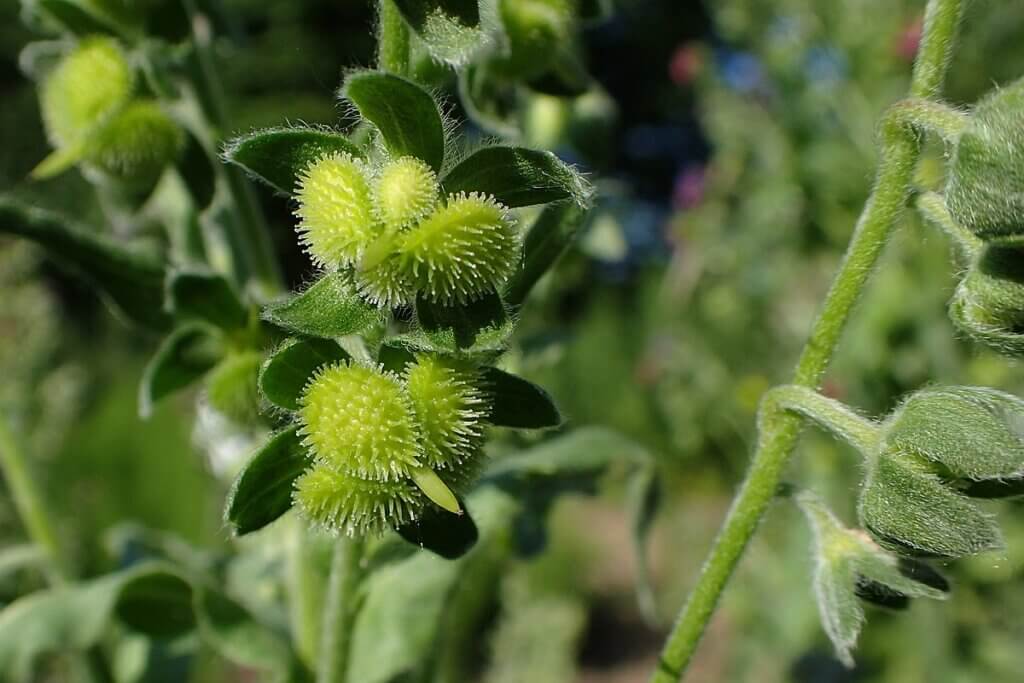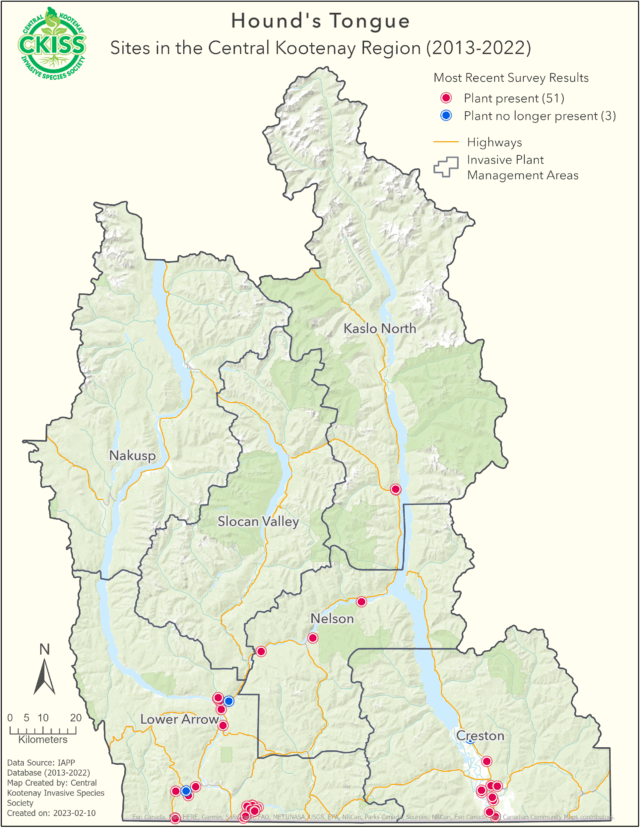Cynoglossum officinale
Description
- Biennial or short-lived perennial that typically grows to 1.5 m tall
- First-year plants form rough, hairy rosettes with flopping leaves that resemble a dog’s tongue
- In the second year of growth, leaves are rough, wide, hairy, alternate, and have prominent veins
- Stems are rough and usually branched in the upper portion
- Flowers are slightly drooping, purplish-red with five petals each, and bloom from coiled stalks
- Each flower produces four seeds that are covered in hooked bristles
- All parts of the plant are covered in long, soft hairs
- A black, woody taproot can reach up to 3’ deep
- Grows on dry, well-drained sites. Usually found on pastures, fields, roadsides, forest rangelands, and disturbed habitats.
Introduction and spread
- Native to Europe
- Likely introduced to North America as a seed contaminant
- Requires disturbance to establish, as it is a weak competitor
- Over-grazing can encourage its spread
- Spreads by seed, which are barbed and cling to clothing and animals
- Each plant can produce 2,000-4,000 seeds per year
- Seeds can remain viable for 3 years if above ground, or 1 year if buried
Consequences of invasion
- Thrives in forested areas and recently logged forest openings
- Displaces native vegetation and alters habitats, reducing native biodiversity
- Toxic to cattle, pigs, horses, goats, and deer – potentially fatal
- Reduces forage for wildlife and livestock
- Can reduce fitness, overall health, and value of livestock
- Barbed seeds may attach/embed around the eye area of animals, impacting eyesight
- Barbed seeds strongly cling to clothing, potentially impacting recreational activities
- Often a contaminant in cereal seed
Status in the CKISS region
- Hound’s tongue has become widespread in the CKISS region and is currently classified as Strategic Control on the CKISS Annual Priority List.
- While it is not realistic to eradicate this species at the landscape level, this species may be treated at high priority sites (e.g. wildlife habitat, corridors of spread, adjacent to agricultural land, restoration sites, etc.) based on specific land management objectives.
- To learn more about how CKISS classifies and manages invasive species, see our Invasive Species Priority Lists page.
Integrated pest management options
Prevention
- Do not plant this species. Learn about Grow Me Instead and PlantWise to grow non-invasive alternatives instead.
- Maintain healthy rangelands to prevent the establishment of this species.
- Immediately revegetate bare, disturbed soils with a non-invasive seed mix to reduce invasion.
- Do not move contaminated soils to a new area.
- Clean your clothing, boots, and gear from soils and plant materials before entering/leaving an area.
- Dispose of seeds either for burial at a landfill or break them in half so they are not viable.
Mechanical control
- Prevent spread by hand-pulling plants and/or removing flowering stems before seeds appear.
- Hand-pull or dig small patches when soils are soft and moist, removing as much of the roots as possible.
- Cut plants below ground level to help prevent re-sprouting.
- Mow before flowering to help prevent seed production and spread.
- Do NOT compost plant material. Bag and dispose of it at a landfill, or burn it.
Chemical control
- Spot treat with herbicide if you cannot effectively dig out the plants.
- Herbicides may be more cost-effective for larger infestations.
- Herbicides that have been reported to be effective: metsulfuron (only on pasture, rangeland, and non-crop sites), 2,4-D (for rosettes), picloram, dicamba, and glyphosate.
Biological control
- The weevil Mogulones cruciger appears to have a significant impact on hound’s tongue.
- Research continues to evaluate other specialized insects and their effects on controlling this species.
Additional resources
- Hound’s tongue | Invasive Species Council of BC
- Hound’s tongue | Fraser Valley Invasive Species Society
- Hound’s tongue | A Guide to Weeds in BC
- Hound’s tongue | King County








